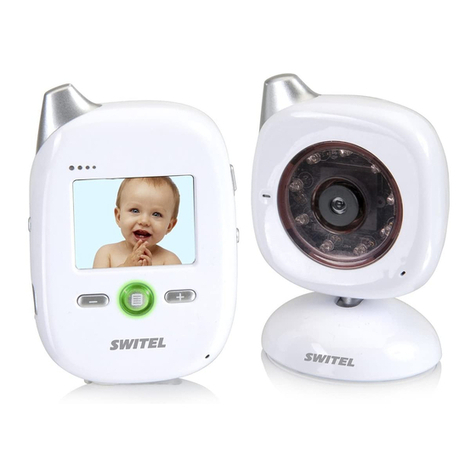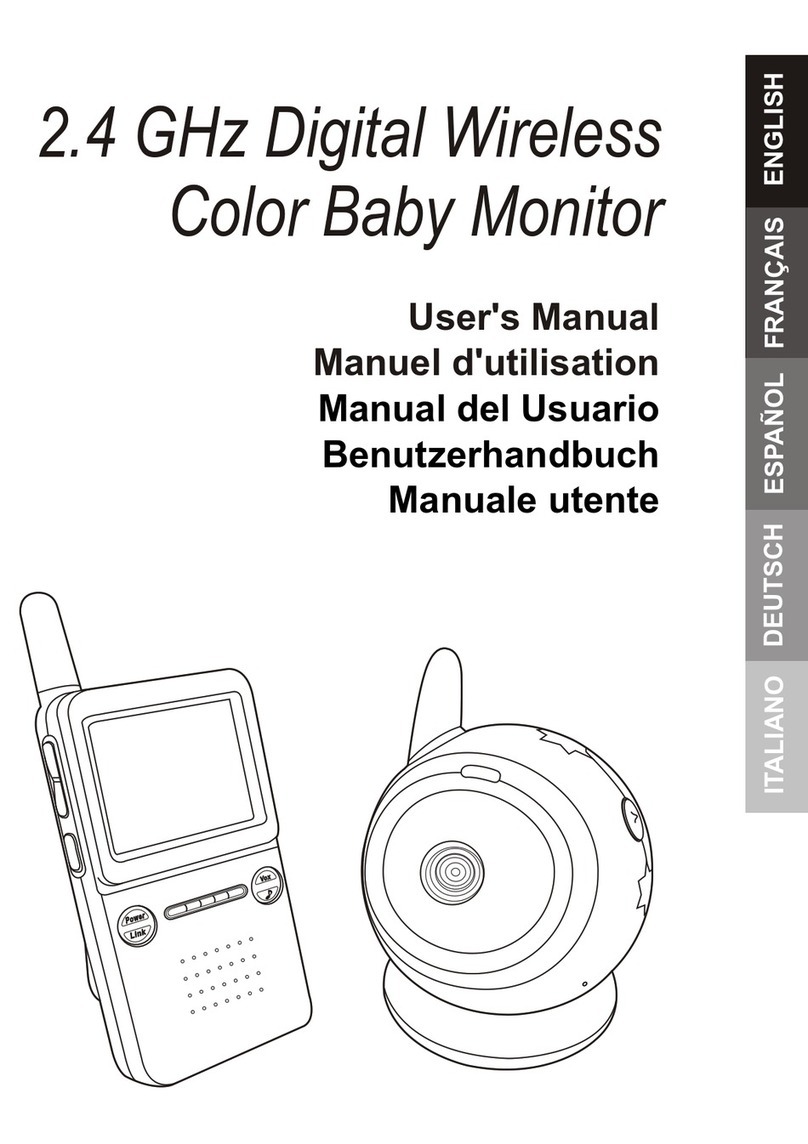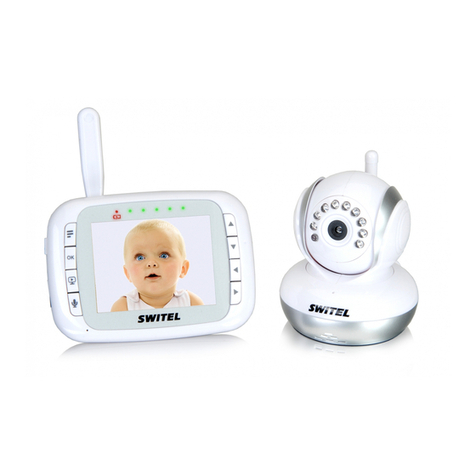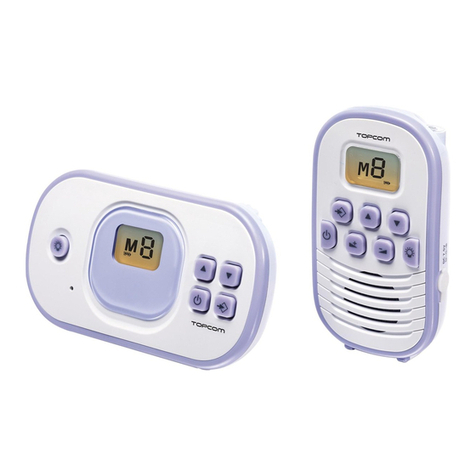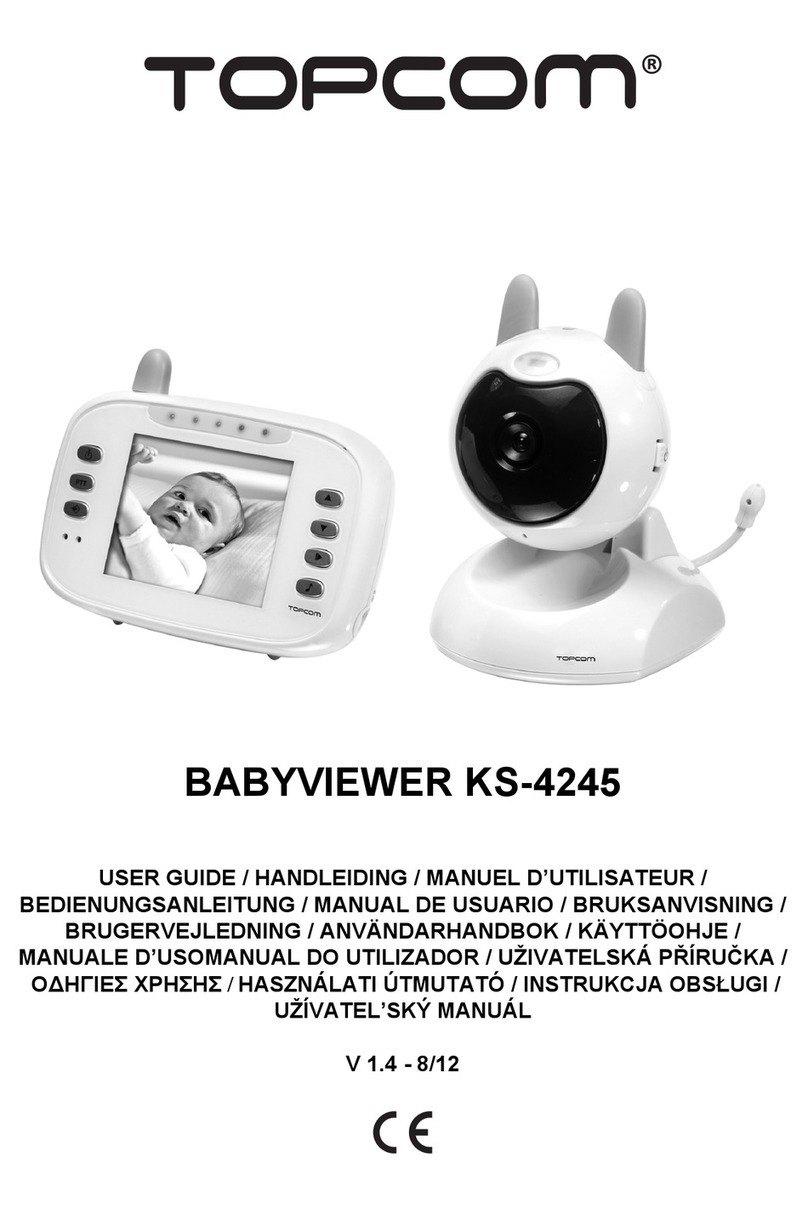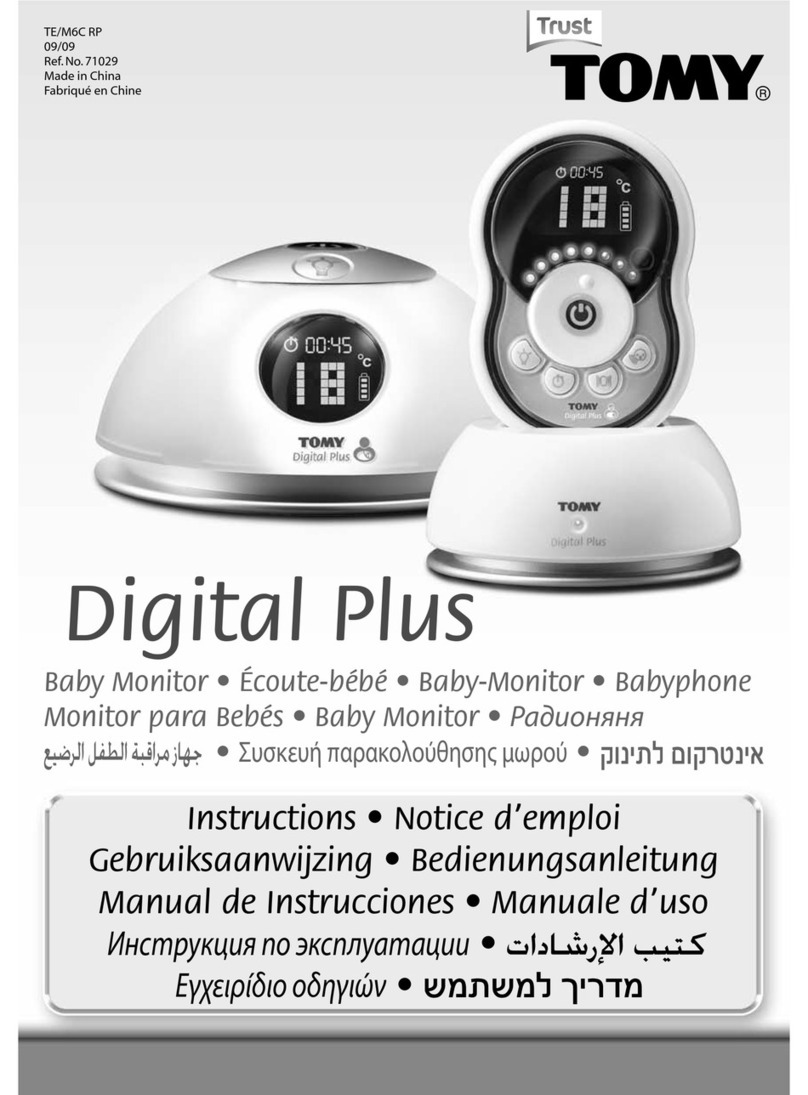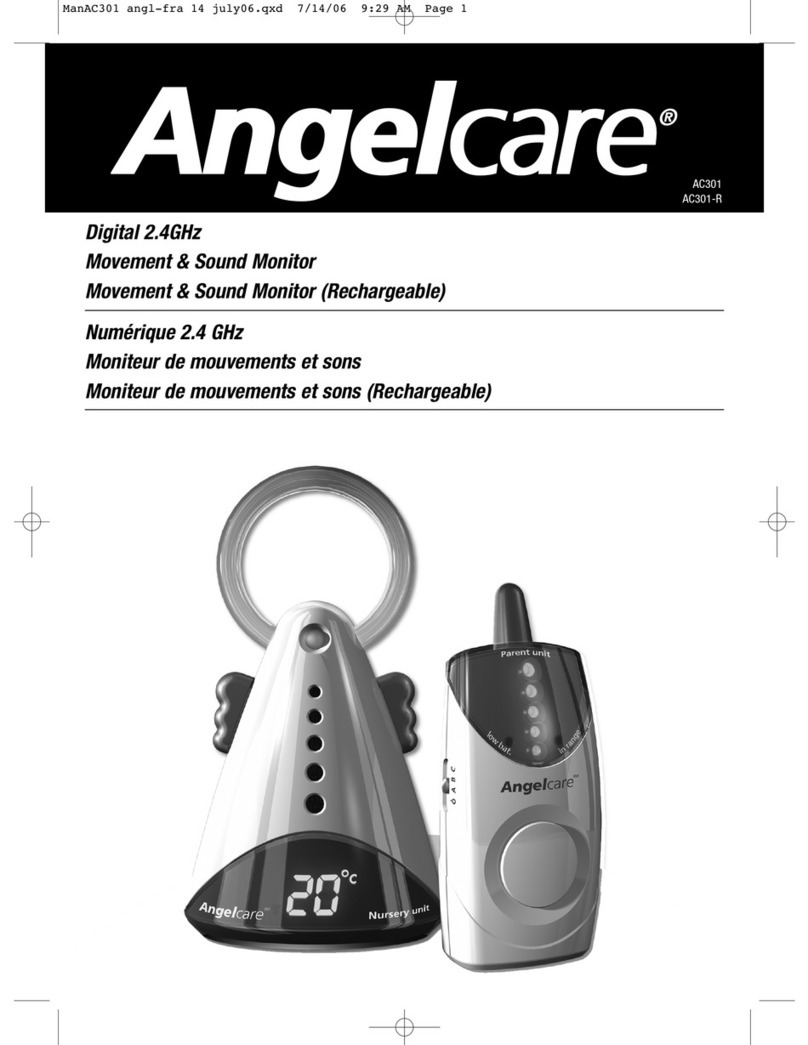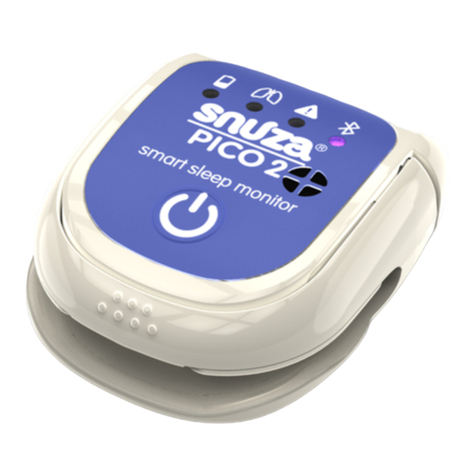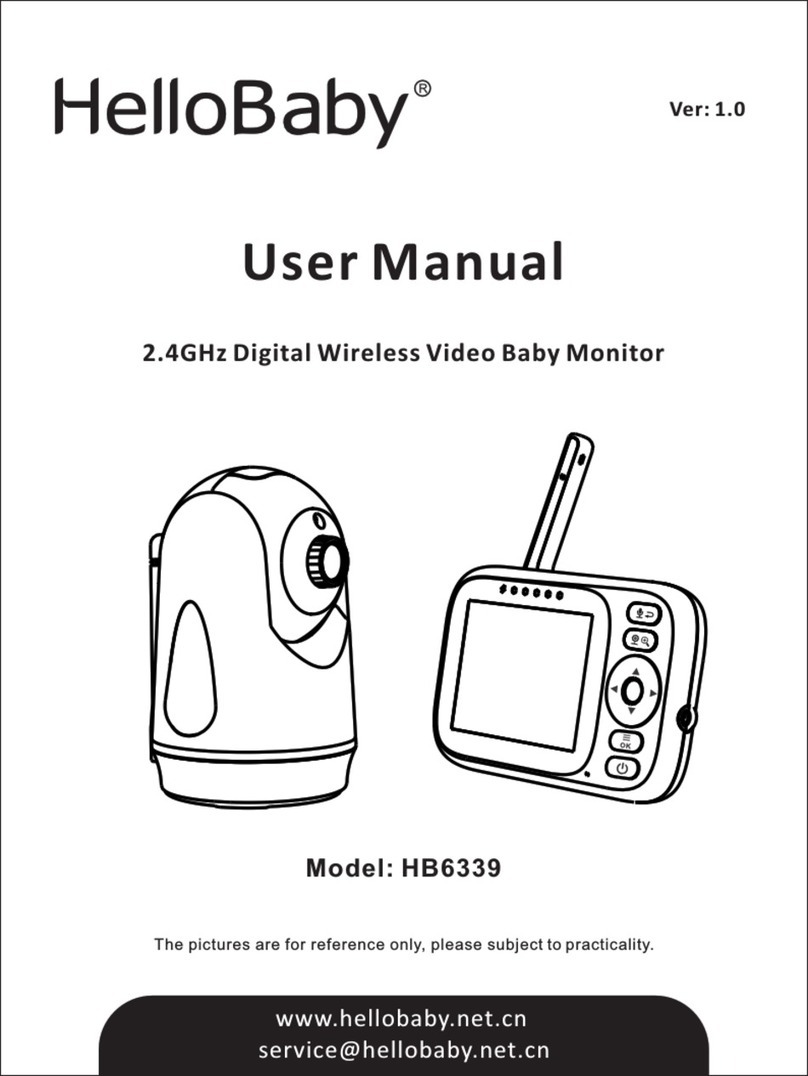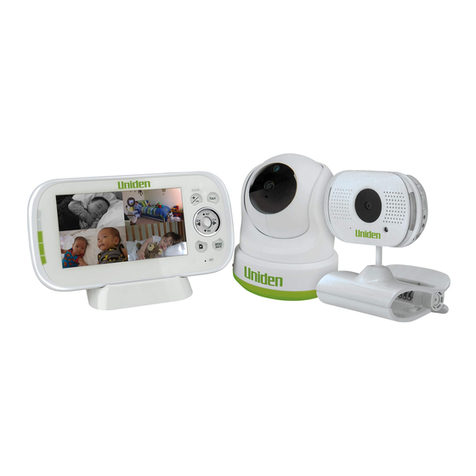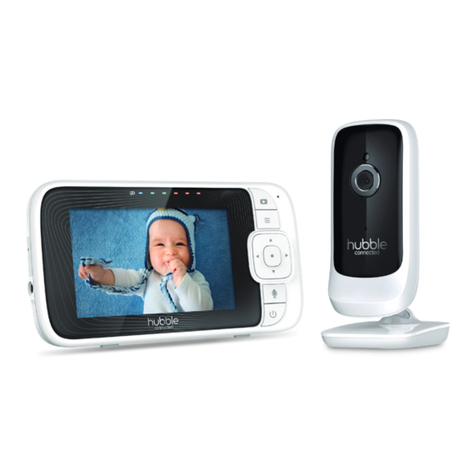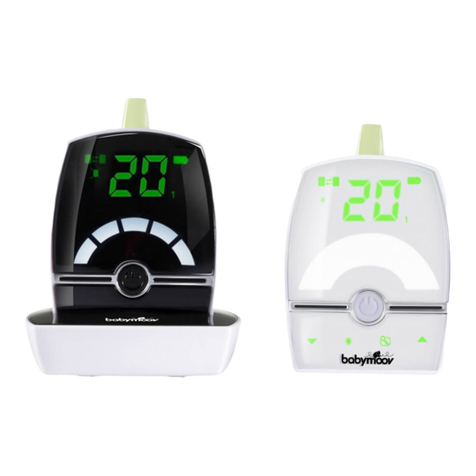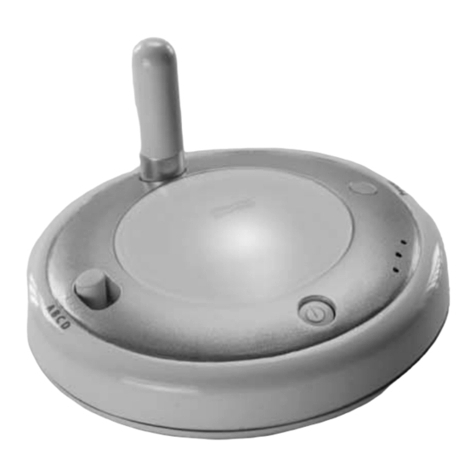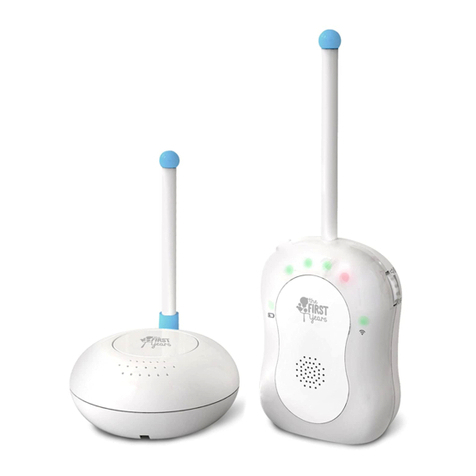switel SP200 User manual

Setting up the Monitor/Configuration du moniteur
/Instalación del monitor/Einrichten des Monitors
/Configurazione del monitor
2
Fine Tuning
Adjust the video image using the V-HOLD, CONTRAST and
BRIGHTNESS adjustment knobs on the back of the monitor, asneeded.
Other Applications
Recording on a VCR
1. The monitor comeswithAV (audio/video)output jacks forconnecting to a
VCR for recording.
2. Connect the AV cable's(option) whiteand yellowplugs tothe whiteand
yellow AV jacks of themonitor and to thewhite andyellow inputjacks ofthe
VCR, matching the plug colors with the jacks on both the monitor and VCR.
See Fig 10.
Night Vision
The camera hassix high-intensity LEDsfor picking up clear images inunlit
locations. To turn on thenight vision function, slidethe switchon thebottom of
the camera. See Fig. 11.
Note: Turning thenight vision functionoff when not required willsave power.
Audio Only
Screen can be turned off foraudio onlymonitoring. To turn off screen,push the
button on the front panel. See Fig 12.
Troubleshooting
If you are not getting anysignal at all
Check the power on the camera and monitor.
Make sure power plugs are pushed all the way in.
Check the channelswitches on bothcamera and monitor are set tothe same
number.
If the camera/monitoris powered bybatteries, replace all batteries with new
ones.
If you canreceive sound, butdon't have images, or the imagesare poor, check
the SCREEN ON/OFFbutton on thefront panel, or adjust theV-HOLD/
CONTRAST/BRIGHTNESS knob onthe backof themonitor.
If the signal is poor,or there is interference
Change the channel settings on both camera and monitor and make them the
same.
If there is a microwave oven in use in the path between the camera and
monitor, removethe microwaveoven orturn itoff.
Make sure the camera and monitor are within range of each other (range of
approximately 300 feet; 100 meters in a clear line of sight).
Precautions
Keep all its parts and accessories out of young children's reach.
The camera's performance can be adversely affected byfingerprints ordirt
on the lens surface. Avoid touching the lenssurface with your fingers.
Should the lensbecome dirty, use ablower to blow off dirtand dust, or a soft,
dry cloth to wipe off thelens.
Keep dry. Precipitation, humidity, and liquids,contain minerals thatwill
corrode electronic circuits.
Do not useor store industy, dirty areas.
Do not store in hot areas. High temperatures can shortenthe life of
electronic devices andwarp or meltcertain plastics.
Do not storein very coldareas. When the system warmsup (to itsnormal
temperature), moisture can form inside the case, which may damage
electronic circuit boards.
Do not attemptto open thecase. Non-expert handling of the devicemay
damage the system.
Avoiddropping and strongimpact.
Operate this product using only the power supply included with it or
provided as an accessory.
Do not overload electrical outlets or extension cords as this can result in fire
or electric shock.
Do remember thatyou are usingpublic airwaves when you use thesystem
and that sound and video may be broadcast to other 2.4 GHz receiving
devices. Conversations, evenfrom rooms nearthe camera, may be broadcast.
Toprotect the privacyof your home, always turn thecamera off when not in
use.
Specifications
English
What You Get
One Camera
One Monitor
Two Power Adapters
Mounting Plate
Fixing Screws and Masonry Plugs
This User's Manual
Note: TheAC adapters CANNOTbe interchanged. Use only the adapter
labeled OUTPUT:9V DCwith the camera. Use only the adapter labeled
OUTPUT: 13.5VDC with the monitor.
Product Layout
Camera (Fig. 1)
1. Infrared LEDs (Six LEDs provide infrared light for night vision.)
2. Lens
3. Lens Head
4. Microphone
5. Keyholes
6. Battery Compartment
7. Power Indicator LED
8. OFF/ON/NIGHT (PowerOFF/power ON andnight vision ON switch.)
9. Channel Selection Switch(Select the channelby sliding the slide switch to
the channel numberyou want. Note: Must selectthe samechannel bothon
the camera and monitor.)
10. 9V Power Adapter Plug
Monitor (Fig. 2)
1. Battery Compartment
2. Screen ON/OFF (Screen can be turnedoff forpure audio monitoring.)
3. Power Indicator LED
4. Power/Volume Control
5. 13.5V Power Adapter Plug
6. Channel Selection Switch(Select the channelby sliding the slide switch to
the channel numberyou want. Note: Must selectthe samechannel bothon
monitor and receiver.)
7. Audio Output Jack(White)
8. Video Output Jack (Yellow)
9. V-HOLD
10. BRIGHT (Brightness)
11. CONT (Contrast)
Setting UP
Before you make the connection:
Make sure the ON/OFF/NIGHTswitch onthe backof thecamera, andthe
Power/Volume Control on thefront of the monitorare inthe OFFposition.
Set the channelswitches on theback of the camera and monitorto the same
channel.
Setting up the Camera
Power Supply
The camera useseither 4AA-Size batteries or household AC current.
To Load Batteries
1. Open the batterycompartment cover onthe back of the camera. See
Fig. 3.
2. Insert batteries 4AA-size batteries,making sure to match the positive
(+) and negative(-) ends tothe diagram insidethe battery compartment.
Please refer toFig 3.
3. Close the battery compartment cover. Make sure the battery
compartment cover islocked securely.
Note 1: Never mix oldbatteries with newones.
Note 2: Remove batteries fromthe camera ifyou do not plan to useit
for a periodof time.
4. Slide the POWER switch to the ON position. The LED on the bottom
of the camera should light up. See Fig. 3.
Using AC Power
1. Plug one end of the provided power adapter into a wall outlet and the
other end into the bottom of the camera. See Fig. 4. Note: Use the
adapter labeled OUTPUT: 9VDC with thecamera.
2. Slide the ON/OFF/NIGHT switchto theON position. The LEDon the
bottom of the camera should light up. See Fig. 4.
Fine Tuning
Place the camerain a convenientlocation, point thelens towards the
observation area andadjust the angleby rotating thelens head. See Fig. 5.
Wall Mounting the Camera
Note: The monitor receptionshould be testedbefore fixing the camera in
place. Have oneperson hold thecamera against the wall in theselected
mounting area while another checks reception on themonitor. If
interference or other problems are present,refer to the Troubleshooting
section. You mayneed toselect adifferent locationin theroom for
mounting the camera.
1. Drill two holes 52mm apart in a line, at the camera mounting position.
2. Fix the provided mounting plate to the wall using the masonry plugs
and fixing screws supplied. See Fig. 6.
3. Place the camera against the mounting plate so that the studs on the
mounting plate enterthe keyholes onthe back of camera. Thenpull
the camera down to slide the studs into the cutout channels. See Fig. 7.
Setting up the Monitor
Power Supply
The monitor uses either 10 C-size batteries or household AC current.
To Load Batteries
1. Open the battery compartment cover on the bottom of the monitor.
See Fig 8.
2. Insert 10 C-size batteries, making sure to match the positive (+) and
negative (-) endsto the diagraminside the battery compartment.
Please refer to Fig 8.
3. Close the battery compartment cover. Make sure the battery
compartment cover islocked securely.
Note 1: Never mix oldbatteries with newones.
Note 2: Remove batteries fromthe camera ifyou do not plan to useit
for a periodof time.
4. Turn themonitor on. The LEDon thefront ofthe monitorshould light
up. See Fig 8.
5. Adjust the volumeto a comfortablelevel.
Using AC Power
1. Plug one end of the provided power adapter into a wall outlet and the
other end into the back of the monitor. See Fig 9. Note: Use the
adapter labeled OUTPUT: 13.5VDC with the monitor.
2. Turn themonitor on. The LEDon thefront ofthe monitorshould light
up. See Fig 9.
3. Adjust the volumeto a comfortablelevel.
Product Layout/Figures des produits/Contenido del paquete
/Produkt-Layout/Descrizione del Prodotto
Setting UP/Configuration/Instalación/Einrichtung/Installazione
1
Français
July, 2002
P/N: 408-000083-00
Figures and Quick Guide/
/
Figures et guide rapide
Figuras y Guía Rápido/Abbildungen und Schnellanleitung
/Figure e guida rapida
User's Manual
Manuel d'utilisation
Manual del Usuario
Benutzerhandbuch
Manuale utente
1
2
1
2
2
1
1
.
.
.
.
.
1
1
2
3
2
Setting up the Camera/Configuration de la caméra
/ ó del Cámara/Einstellen des Kamera
/Configurazione della telecamera
Configuraci n
To Load Batteries/Insérer les piles/Caragar las Baterías
/Einlegen der Batterien/Per mettere le batterie
Using AC Power/Utilisation de l'alimentation AC//Usar Corriente AC
/Benutzen von Netzstrom/Uso della corrente AC
Power Supply/Alimentation/Alimentación/Stromversorgung
/Alimentazione
1.1
To Load Batteries/Insérer les piles/Caragar las Baterías
/Einlegen der Batterien/Per mettere le batterie
Power Supply/Alimentation/Alimentación/Stromversorgung
/Alimentazione
2.1
Fig. 1
Fig. 2
Fig. 3
Fig. 4
1
1
.
.
2
3
3
Fine Tuning/Optimisation/ /Feineinstellung
/Sintonizzazione
Sintonía Fina
Wall Mounting the Camera/Montage mural de la caméra
/Montaje de la Cámara en la Pared
/Anbringen der Kamera an einer Wand
/Montaggio della fotocamera al muro
Fig. 7
Fig. 8
Fig. 9
Specifications subject tochange without notice
0678
Declaration of Conformity
Hereby, TRANWO TECHNOLOGY CORP., declares that this TTA-32T/TTA-52R is in compliance with the essential
requirements and other relevant provisions of Directive 1999/5/EC.
FCC Statement
This equipment has been tested and found to comply with the limits for a Class B digital device, pursuant to Part 15 of
the FCC Rules. These limits are designed to provide reasonable protection against harmful interference in a residential
installation. This equipment generates, uses and can radiate radio frequency energy and, if not installed and used in
accordance with the instructions, may cause harmful interference to radio communications. However, there is no
guarantee that interference will not occur in a particular installation. If this equipment does cause harmful interference to
radio or television reception, which can be determined by turning the equipment off and on, the user is encouraged to try
to correct the interference by one or more of the following measures:
Reorient or relocate the receiving antenna
Increase the separation between the equipment and receiver
Connect the equipment into an outlet on a circuit different from that to which the receiver is connected
Consult the dealer or an experienced radio/TV technician for help
FCC Label Compliance Statement:
This device complies with Part 15 of the FCC Rules. Operation is subject to the following two conditions: (1) this device
may not cause harmful interference, and (2) this device must accept any interference received, including interference that
may cause undesired operation.
Note: The manufacturer is not responsible for any radio or TV interference caused by unauthorized modifications to this
equipment. Such modifications could void the user's authority to operate the equipment.
Monitor
Frequency 2.4 GHz
Channel 3 selectable channels
A/V mod/demod. method FM
Display 5.5 inch B/W monior
Resolution at Center V: 350 lines
H: 300 lines
Sound max. output 800mW
Dimensions 15.5(W) x17(H) x 20(D) cm
(6.1 x 6.7 x 7.9 inches)
Weight 1310g (46.2 ounces) without batteries
Power DC 13.5V, 1000mA
or 10 C-size batteries
Operating temperature 0 ~ 40 (32 ~ 104 )
Camera
Frequency 2.4 GHz
Channel 3 selectable channels
A/V mod/demod. method FM
Image Sensor 1/4” CMOS image sensor
Effective pixels EIA: 320 (H) x 240 (V)
CCIR: 352 (H) x 288 (V)
Lens f 3.6mm, F 2.0
Dimensions 9.2(W) x 12.3(H) x 5.9(D) cm
(3.6 x 4.8 x 2.3 inches)
Weight 175g (6.17 ounces) without batteries
Power DC 9V, 300mA or 4AA-size batteries
Operating temperature 0 ~ 40 (32 ~ 104 )
Utilisation de l'alimentation AC
1. Branchez l'une des extrémité de l'adaptateur de courant fourni dans
une prise murale,et l'autre extrémitéà l'arrière du moniteur. Voir Fig
9. Remarque: Utilisez seulement l'adaptateur libellé SORTIE:9V DC
avec le moniteur.
2. Mettez le moniteur sous tension. Le LED qui se trouve à l'avant du
moniteur s'allume. Voir Fig 9.
3. Ajustez les contrôlesdu volume àun niveau confortable.
Optimisation
Ajustez l'image vidéoen utilisant lesboutons d'ajustement STABILITÉ,
CONTRASTE et LUMINOSITE qui se trouventà l'arrière du moniteur.
Autres applications
Enregistrer sur un magnétoscope
1. Le moniteur est équipé de prises de sortie Audio/Vidéo pour une connexion
avec un magnétoscopequi enregistre.
2. Connectez les fichesblanche et jaunedu câble audio/vidéo aux prises
audio/vidéo blanche etjaune du moniteur, ainsi qu'auxprises d'entrée
blanche et jaunedu magnétoscope, enfaisant correspondre les couleurs des
fiches avec lescouleurs des prisessur le moniteur et sur lemagnétoscope.
Voir Fig 10.
Vision de Nuit
La caméra estéquipée de sixLED de haute intensité pour pouvoirrecueillir des
images des endroitssombres. Afin d'activer lafonction Vision de nuit,placez le
bouton comme il est indiqué dans l'illustration dedroite. Voir Fig. 11.
Remarque: En désactivant lafonction Vision de Nuitlorsqu'elle n'est pas
requise, vous économiserezde l'énergie.
Audio Seulement
L'écran peut etre éteint pour une surveillance audio seulement. Afin d'éteindre
l'écran, poussez le bouton sur le panneau de face comme le montre l'illustration
de droite. Voir Fig 12.
Dépannage
Si vous n'avez aucun signal
Vérifiez que la caméra et le moniteur sont sous tension.
Assurez-vous que lesprises de courantsont enfoncées jusqu'au bout.
Vérifiez que les sélecteurs de canaux de la caméra et du moniteur sont
configurés sur lemême chiffre.
Si la caméra/le moniteur sontsur piles, remplacez toutes les pilesavec des
piles neuves.
Si vous pouvezrecevoir du son,mais aucune image, ou bien queles images
sont de mauvaise qualité, vérifiez le bouton Allumé/Eteint du panneau de
face, ou ajustezle bouton STABILITÉ/CONTRASTE/LUMINOSITE à
l'arrière du moniteur.
Si le signal est de mauvaisequalité, ou qu'il y a des interférences
Changez le canalde la caméraet du récepteur et assurez-vous quece soit le
même sur les deux.
Si il y a un four à micro-ondesentre la caméra etle récepteur,éloignez-le ou
éteignez-le.
Assurez-vous que lacaméra et lemoniteur sans à distance acceptable
(environ 100 mètres sans obstacle).
Précautions d'emploi
Conservez toutes lesparties et accessoiresde l'appareil hors de portée des
enfants.
Les performances de la caméra peuvent être affectéespar des empreintes de
doigt ou dela poussière surla surface de l'objectif. Évitez doncde toucher à
la surface de l'objectif.
Si l'objectif venaità se salir, utilisez unsouffleur pour souffler lessaletés et
la poussière, ou un chiffon douxet sec pour essuyerl'objectif.
Conserver les appareilsau sec. La pluie, l'humidité, etles liquides,
contiennent des minérauxqui peuvent provoquerla corrosion des circuits
électroniques.
Ne placez pasles appareils dansdes endroits poussiéreux et sales.
Ne stockez pasles appareils dansdes endroits chauds. Les hautes
températures peuvent raccourcirla durée devie des composants
électroniques ou fairefuir et mélangercertains plastiques.
Ne placez pas les appareils dans des endroitsfroids. Lorsque l'unité chauffe
(jusqu'à sa température normale), de lamoisissure peut se formerà l'intérieur
du boîtier,ce qui peutendommager les circuits électroniques.
N'essayez pas d'ouvrir le boîtier. Une manipulation effectuée parun non-
expert peut endommagerl'appareil.
Evitez de laissertomber les appareilsou de leur faire subire deschocs.
Ne faîtes fonctionnerce produit qu'avecla source d'alimentation qui est
inclue et quiest fournie avecses accessoires.
Ne surchargezpas les prisesélectriques ou les rallonges car celapourrait
causer un incendieou des chocsélectriques.
Veuillez vous rappeler quevous utilisez les ondes publiques lorsque vous
mettez le système en opération, et que leson et la vidéopeuvent doncêtre
transmis vers d'autres appareils de réceptionà 2.4 GHz. Lesconversations,
même si ellesont lieu dansdes pièces différentes de celleoù se trouve la
caméra, peuvent doncêtre transmises.Afin de protéger votre vie privée,
veillez donc àtoujours mettre lacaméra hors tension lorsqu'elle n'est pas
utilisée.
Ce que vous avez
Une caméra
Un moniteur
Deux adaptateurs
Plateau montant
Vis de fixation etchevilles de maçonnerie
Manuel de l'utilisateur
Remarque: Les adaptateurs secteurNE PEUVENTPAS être échangés.
Utilisez l'adaptateur marquéSORTIE: 9V DC avec lacaméra. Utilisez
l'adaptateur marqué SORTIE : 12Vavec l'écran.
Figures des produits
Caméra (Fig. 1)
1. LED Infrarouges (Six LED qui fournissentune lumièreinfra-rouge pourune
vision de nuit.)
2. Objectif
3. Tête d'objectif
4. Microphone
5. Trous deserrure
6. Compartiment des piles
7. LED Indicateur d'Alimentation
8. Eteint/Allumé/Nuit (OFF/ON/NIGHT. Bouton Pour laMise sous
tension/Hors tension et la Visionde Nuit.)
9. Bouton de sélection des canaux (Sélectionnez le canal en tournant le bouton
vers le numérodu canal quevous désirez configurer. Remarque: Vous
devez choisir le même canal sur la caméra et sur le récepteur.)
10. Prise de l'Adaptateur secteur 9V
Monitor (Fig. 2)
1. Compartiment des piles
2. Ecran Allumé/Eteint (L'écran peutêtre éteint lors d'une surveillance
uniquement audio.)
3. LED indicateur d'alimentation
4. Contrôle Alimentation/Volume
5. Prise de l'adaptateur de courant 13.5V
6. Bouton de sélection des canaux (Sélectionnez le canal en tournant le bouton
vers le numérodu canal quevous désirez configurer. Remarque: Vous
devez choisir le même canal sur la caméra et sur le récepteur.)
7. Prise Audio (Blanche)
8. Prise Vidéo (Jaune)
9. Stabilité image (V-HOLD)
10. Luminosité (BRIGHT)
11. Contraste (CONT)
Configuration
Avantde procéderà laconnexion:
Assurez-vous que leboutonALLUMÉ/ÉTEINT/NUIT à l'arrière de la
caméra, et que le contrôle Alimentation/Volume sur le devantdu moniteur
sont bien dans la position ÉTEINT.
Configurez les interrupteurs de canaux à l'arrière de la caméra et du
moniteur sur lemême canal.
Configuration de la caméra
Alimentation
La caméra utilise soit 4 piles AAsoit l'alimentation secteurAC.
Insérer les piles
1. Ouvrez l'emplacement despiles à l'arrièrede la caméra. Voir Fig. 3.
2. Insérez les pilesen faisant correspndreles signes (+)et moins (-) des
piles et dudiagramme situé àl'intérieur de l'emplacementpour les piles.
Veuillez vous reporter à la Fig3.
3. Refermez le portillondu compartiment despiles. Assurez-vous que le
portillon est correctementrefermé.
Remarque 1: Ne mélangez jamaisdes piles usagéeset des piles
neuves.
Remarque 2: Retirez les pilesde la camérasi vous ne comptez pas
vous en servirpendant une longuepériode.
4. Placez l'interrupteurALIMENTATION sur laposition ALLUMÉ. Le
LED qui setrouve à l'arrièrede la caméra s'allume. Voir Fig. 3.
Utilisation de l'alimentation AC
1. Branchez l'une desextrémités du câblequi est fourni dans la prise
murale et l'autreextrémité à l'arrièrede la caméra. Voir Fig. 4.
Remarque: Utilisez seulement l'adaptateur libellé SORTIE: 9V DC
avec la caméra.
2. Placez le boutonALLUMÉ/ÉTEINT/NUITsur la position ALLUMÉ.
Le LED quise trouve àl'arrière de la caméra s'allume. Voir Fig. 4.
Optimisation
Placez la caméra dans un endroitconvenable, faites pointerson objectif
vers la zone à observer etajustez l'angle eneffectuant une rotationde la
tête de l'objectif. Voir Fig. 5.
Montage mural de la caméra
Remarque: La bonne réceptiondu moniteur doitêtre testée avant la
mise en placede la caméra. Une personne doit tenir la caméracontre le
mur à l'emplacement où elle doit être fixèe,alors qu'une autre personne
vérifie la qualité de la réception sur lemoniteur. Si des interférences ou
d'autres problèmes apparaissent, veuillez choisir unautre emplacement
pour fixer lacaméra.
1. Faites deux trousà 52 mmde distance et alignés, là oùla caméra doit
être installée.
2. Fixez le plateau montant au mur en utilisant les attaches et en fixant
les vis fournis. Voir Fig. 6.
3. Placez la caméracontre le plateaumontant de manière à ce que les
montants du plateauentre dans lestrous de serrure à l'arrière dela
caméra. Puis tirezla caméra versle bas pour faire glisser lesmontants
dans les découpages. Voir Fig. 7.
Configuration du moniteur
Alimentation
Le moniteur utilise soit 10 piles de taille C ou l'alimentation secteur AC.
Insérer les piles
1. Ouvrez le portillondu compartiment despiles dans le sens de laflèche.
Voir Fig 8.
2. Insérez les pilesen faisant correspndreles signes (+) et moins (-)des
piles et dudiagramme situé àl'intérieur de l'emplacement pour les
piles. Veuillez vousreporter àla Fig 8.
3. Refermez le portillondu compartiment despiles. Assurez-vous que le
portillon est correctementrefermé.
Remarque 1: Ne mélangez jamaisdes piles usagéeset des piles
neuves.
Remarque 2: Retirez les pilesde la camérasi vous ne comptez pas
vous en servirpendant une longuepériode.
4. Mettez le moniteur sous tension. Le LED qui se trouve à l'avant du
moniteur s'allume. Voir Fig 8.
5. Ajustez les contrôlesdu volume àun niveau confortable.
1
2
1
2
2
1
1
.
.
.
.
.
1
1
2
3
2
Camera/Caméra/Cámara/Kamera/Telecamera
Monitor/Moniteur
1
Other Applications/Autres applications/Otras aplicaciones
/Andere Anwendungen/Altre applicazioni
IN
VIDEO AUDIO
VCR
(White)/(blanche)/(blanca)
/(weiß)/(bianca)
Recording on a VCR/Enregistrement sur un magnétoscope
/Grabar con una VCR/Aufnahme auf einen Videorecorder
/Registrazione su un VCR
Night Vision/Vision de Nuit/Visión Nocturna/Nachtansicht/Visione notturna
Audio Only/Audio seulement/Solamente Audio/Nur Audio
/Solo Audio
Fig. 10
Fig. 12
(white)
/(blanche)
/(blanca)
/(weiß)
/(bianca)
(Yellow)
/(jaune)
/(amarilla)
/(gelb)
/(gialla)
(yellow)
/(jaune)
/(amarilla)
/(gelb)
/(gialla)
2
3
4
5
6
7
8
9
10
1
2
3
4
5678910 11
1
3
2
2
1
Fig. 5
Fig. 6
2
3
3
1
Fig. 11
12
1
2
Using AC Power/Utilisation de l'alimentation AC//Usar Corriente AC
/Benutzen von Netzstrom/Uso della corrente AC
2.4 GHz Wireless B/W Security System

Deutsch ItalianoEspañol
Usar Corriente AC
1. Enchufe un extremodel adaptador decorriente en la ficha de corriente
de la paredy el otroextremo en la parte posterior delmonitor. Vea la
Fig. 9. Nota: Use sólo el adaptadoretiquetado SALIDA: 13.5V DC
con el monitor.
2. Encienda el monitor. El LED en la parte frontal del monitor debe
permanecer iluminado. Vea la Fig. 9.
3. Ajuste el volúmena un nivelque le agrade.
Sintonía Fina
Ajuste la imagende vídeo usandolos desviadores para ajustar V-
MANTENER, CONTRASTE yBRILLO enla parteposterior delmonitor,
según sea necesario.
Otras aplicaciones
Grabar con una VCR
1. El monitor vienecon clavijas desalida para Audio/Vídeo para conectara la
VCR al grabar.
2. Conecte los enchufesdel cable blancoy amarillo para audio/vídeo a las
clavijas blanca y amarilla para audio/vídeo del monitor,y a las clavijasde
entrada blanca yamarilla de laVCR, coincidiendo el color delos enchufes
con el color de las clavijas tanto enel monitor como enla VCR. Vea laFig.
10.
Visión Nocturna
La cámara tieneseis LEDs dealta intensidad para recoger imágenes clarasen
lugares con pocailuminación. Para encender la función devisión nocturna,
deslice la tecla como se muestra en lailustración de la derecha. Vea la Fig. 11.
Nota: Apague la funciónde visión nocturnacuando no la use, para ahorrar
energía.
Solamente Audio
La pantalla puedeser apagada paramonitorear solamente el audio. Para apagarla
pantalla, presione elbotón en elpanel frontal como muestra la ilustraciónde la
derecha. Vea la Fig. 12.
Resolviendo Problemas
Si no obtiene señal alguna
Verifique el encendido enla cámara y el monitor.
Asegúrese de quelos enchufes decorriente han sido insertados hasta elfinal.
Verifique que el desviador de CANALEStanto en la cámara como enel
monitor están definidos en el mismo número.
Si la cámara/monitor está alimentadospor baterías, reemplace todas las
baterías por otrasnuevas.
Si puede recibirsonido, pero notiene imágenes, o las imágenes sonpobres,
verifique el botónPANTALLA ENCENDIDA/APAGADAen el panelfrontal,
o ajuste eldesviador V-MANTENER/CONTRASTE/BRILLO en la parte
posterior del monitor.
Si la señal es pobre, ohay interferencia
Cambie la definición de canal tanto en la cámara como en el monitor y
colóquelos en el mismo número.
Si hay un horno microondas en uso en el camino entre la cámara y el monitor,
remueva el horno microondas o apáguelo.
Asegúrese de quela cámara yel monitor están dentro de ladistancia
recomendada (distancia deaproximadamente 300 pies,100 metros sin
obstrucciones).
Precauciones
Mantenga todas sus piezas y accesorios lejos de los niños.
El rendimiento dela cámara puedees afectada por huelgas digitales o
suciedad en la superficie de la lente. Evite tocar la superficie de la lente con
sus dedos.
Para limpiar el objetivo use un soplador o un paño blando y seco.
Mantenga seco. Precipitación, humedad y líquidoscontienen minerales que
corroen los circuitos electrónicos.
No use nialmacene enlocales sucioso polvorientos.
No almacene enlocales calientes. La alta temperatura puedereducir la
duración de los dispositivos electrónicos e deformar o derretir los plásticos.
No almacene enlocales excesivamente fríos. Cuando el aparato se calienta
(hasta su temperaturanormal), la humedadse forma en el interior dela caja,
lo que puede dañar los circuitos electrónicos.
No intente abrir la caja. Este dispositivo puede dañarse con el manejo por
personas no expertas.
Evite dejar caer o causar fuertes impactos.
Use este producto usando solamente la fuente de alimentación u otros
accesorios suministrados.
No sobrecarguelos tomacorrientes olas extensiones. Esto puede causar
incendio o choque eléctrico.
Tengasiempre en cuentaque está utilizando la banda deuso público general
al usar el sistema y que el sonido y el video pueden ser transmitidos a otros
dispositivos receptores de 2,4 GHz. Conversaciones, aun de una sala a otra
cerca de la cámara pueden ser transmitidas. Para proteger la privacidad de su
casa, apague la cámara cuando no está en uso.
Contenido del paquete
Una Cámara
Un Monitor
Dos Adaptadores de Corriente
Placa de montaje
Tornillosde fijación ybujes
Este Manual delUsuario
Nota: Los adaptadores AC de corriente NO DEBEN serintercambiados. Use
solo el adaptadoretiquetado SALIDA: 9VDC con lacámara. Use sóloel
adaptador etiquetado SALIDA: 13.5VDC conel monitor.
Diseño del Productor
Cámara (Fig. 1)
1. LEDs Infrarrojos (Seis LEDs proporcionan luz infrarroja para visión
nocturna.)
2. Objetivo
3. Cuerpo del objetivo
4. Micrófono
5. Agujeros de montaje
6. Compartimento para Baterías
7. LED Indicador deCorriente
8. APAGADO/ENCENDIDO/NOCTURNO(OFF/ON/NIGHT,Tecla
APAGADO/ENCENDIDOy ENCENDIDOVISION NOCTURNA.)
9. Selector de Canal(Seleccione el canalal correr la tecla deslizadora hastael
número de canalque quiere. Nota: Debe seleccionar enmismo canal para la
cámara y el monitor.)
10. Enchufe Adaptador de Corriente 9V
Monitor (Fig. 2)
1. Compartimento para Baterías
2. Pantalla ENCENDIDA/APAGADA (La pantallapuede ser apagada para
monitorear sólo el audio.)
3. LED Indicador deCorriente
4. Control deAlimentación Eléctrica / Volumen
5. Enchufe Adaptador de Corriente 13.5V
6. Selector de Canal(Seleccione el canalal correr la tecla deslizadora hastael
número de canalque quiere. Nota: Debe seleccionar enmismo canal para la
cámara y el monitor.)
7. Clavija deAudio (Blanca)
8. Clavija de Video (Amarilla)
9. V-MANTENER(V-HOLD)
10. BRILLO (BRIGHT)
11. CONTRASTE (CONT)
Instalación
Antes de hacer la conexión:
Asegúrese de queel conmutador ENCENDIDO/ APAGADO/ NOCHE en la
parte trasera dela cámara yel control y el control deAlimentación Eléctrica/
Volumen en la partefrontal del monitor esténen laposición deAPAGADO.
Ajuste los interruptoresde canal enla parte trasera de la cámaray del
monitor en el canal deseado.
Instalación de la Cámara
Fuente de Energía
La cámara utiliza4 pilas tamañoAA o la energía eléctrica CAdoméstica.
Cargar las Baterías
1. Abra el compartimientode las pilasen la parte trasera de lacámara.
Vea la Fig. 3.
2. Inserte las pilashaciendo coincidir lossignos (+) ymenos (-) según el
esquema dentro delcompartimiento de laspilas. Vea la Fig. 3.
3. Cierre la tapa del compartimento de baterías. Asegúrese de que la tapa
del compartimento debaterías está cerradacorrectamente.
Nota 1: Nunca mezcle bateríasviejas con baterías nuevas.
Nota 2: Remueva lasbaterías de la cámara si no planea usarla por un
período de tiempo.
4. Ponga en ENCENDIDOel interruptor dealimentación eléctrica. El
LED en laparte inferior dela cámara debe permanecer iluminado. Vea
la Fig. 3.
Usar Corriente AC
1. Conecte una puntadel adaptador suministradoal tomacorriente en la
pared y la otra en la parte inferior de lacámara. Vea la Fig. 4.
Nota: Use sólo eladaptador etiquetado SALIDA:9V DC con la
cámara.
2. Deslice el conmutadorENCENDIDO /APAGADO / NOCHE ala
posición de ENCENDIDO. El LED enla parte inferior dela cámara
debe permanecer iluminado. Vea laFig. 4.
Sintonía Fina
Coloque la cámara en un localadecuado, a apunteel objetivo haciael área
de observación y ajuste el ángulogirando el cuerpodel objetivo. Vea la
Fig. 5.
Montaje de la Cámara en laPared
Nota: Antes de sujetar la cámara pruebe la recepción del monitor.
Coloque a unapersona sosteniendo lacámara contra la pared en elárea
seleccionada para montaje mientras que otra persona verifica la recepción
del monitor. Si se presentainterferencia oproblemas deotro tipo,deberá
seleccionar una ubicacióndiferente para montarla cámara.
1. Taladredos agujeros separados52 mm, en la posición demontaje de la
cámara.
2. Fije la placa de montaje en la pared usando los bujes y tornillos
suministrados. Vea la Fig. 6.
3. Coloque la cámara contra la placa de montaje de manera que los
espárragos en laplaca de montajeentren en los agujeros en laparte
trasera de la cámara. Después tire de la cámara hacia abajo para
deslizar los espárragos en los canales recortados. Vea laFig. 7.
Instalación del monitor
Fuente de Energía
El monitor emplea pilas tamaño 10 C o alimentación eléctrica CA
doméstica.
Cargar las Baterías
1. Abra la tapa del compartimento de baterías en la dirección indicada
por la lecha. Vea la Fig 8.
2. Inserte las pilashaciendo coincidir lossignos (+) y menos (-) según el
esquema dentro del compartimiento de las pilas. Vea laFig. 8.
3. Cierre la tapa del compartimento de baterías. Asegúrese de que la tapa
del compartimento debaterías está cerradacorrectamente.
Nota 1: Nunca mezcle bateríasviejas con baterías nuevas.
Nota 2: Remueva lasbaterías de la cámara si no planea usarla por un
período de tiempo.
4. Encienda el monitor. El LED en la parte frontal del monitor debe
permanecer iluminado. Vea la Fig 8.
5. Ajuste el volúmena un nivelque le agrade.
1
2
1
2
2
1
1
.
.
.
.
.
1
1
2
3
2
Benutzen von Netzstrom
1. Stecken Sie daseine Ende desNetzteils in eine Netzsteckdose und das
andere Ende in den Anschluss auf der Rückseite des Monitors. Siehe
Fig. 9. Hinweis: Benutzen Sie das Netzteil,das mit OUTPUT: 13.5V
DC bezeichnet ist, nur für den Monitor.
2. Schalten Sie denMonitor ein. Die LED auf derVorderseite des
Monitors sollte aufleuchten. Siehe Fig. 9.
3. Stellen Sie die Lautstärke auf eine angenehme Höhe ein.
Feineinstellung
Stellen Sie dasVideobildmit Hilfe der Schaltknöpfe V-HOLD,
KONTRAST undHELLIGKEIT aufder Rückseitedes Monitorsein.
Andere Anwendungen
Aufnahme auf einen Videorecorder
1. Der Monitor besitztAudio/Video-Output-Buchsen zum Anschließen eines
Videorecorders für dieAufnahme.
2. Schließen Sie dieweißen und gelbenStecker des Audio/Videokabels an die
Audio/Video-Buchsen des Monitors unddie Input-Buchsen des
Videorekorders an, wobei diedie Farben der Stecker mit denFarben der
Buchsen übereinstimmen sollten. Siehe fig. 10.
Nachtansicht
Die Kamera besitztsechs leistungsfähige LEDszur Aufnahme von klaren
Bildern in dunklerUmgebung. Wenn Sie die Nachtansicht-Funktion benutzen
wollen, schieben Sieden Schalter wiein der Abbildung gezeigt nachrechts.
Siehe Fig. 11.
Hinweis: WennSie die Nachtansicht-Funktionnicht benötigen, sollten Sie sie
ausschalten, um Strom zu sparen.
Nur Audio
Der Bildschirm kann ausgestellt werden, wenn Sie nur Audio verwenden wollen.
WennSie den Bildschirmausschalten wollen, drücken Sie dieTaste auf der
Vorderseite des Monitors wiein der Abbildunggezeigt. Siehe Fig. 12.
Problembehebung
Wenn Sie kein Signal erhalten
Gberprüfen Sie die Stromversorgungvon Kameraund Monitor.
Gehen Sie sicher, dasalle Netzsteckerkorrekt eingestecktsind.
Gehen Sie sicher, dassdie Kanal-Schalterauf derKamera unddem Monitor
auf den gleichen Kanal eingestellt sind.
WennKamera/Monitor mit Batterienbetrieben wird, ersetzen Sie die
Batterien durch neue.
WennSie nurTonund kein Bild empfangen, oder wenndie Bildqualität
schlecht ist, überprüfenSie den SCREENON/OFF-Schalter auf der
Vorderseite oder stellen denV-HOLD/ KONTRAST/HELLIGKEIT-Knopf
auf der Rückseite des Monitors ein.
Wenn das Signal schlecht ist, oder es Störungengibt
Wählen Sie einen anderen Kanal für die Kamera und den Monitor.
Entfernen Sie ein Mikrowellengerät, wenn es sich zwischen Kamera und
Monitor befindet, oder schalten Sie es aus.
Gehen Sie sicher, dass derAbstandzwischen Kamera undMonitor nicht zu
groß ist (maximal 100 Meter (300 feet) bei klarer Sicht).
Vorsichtsmaßnahmen
Halten Sie alle Teile und Zubehör außerhalbder Reichweite von Kindern.
Die Kameraleistung kanndurch Fingerabdrücke oderSchmutz auf dem
Objektiv beeinträchtigt werden. Vermeiden Sie das Berührendes Objektivs
mit Ihren Fingern.
Wenndas Objektiv verschmutztist, benutzen Sie ein Gebläse, umSchmutz
oder Staub wegzublasen, oder benutzen ein weiches trockenes Tuch zum
Wischen.
Halten Sie das Gerät trocken. Niederschlag, Feuchtigkeit und Flüssigkeiten,
die Mineralien enthalten, können Rostbildung am elektronischen Kreislauf
verursachen.
Benutzen Sie dieGeräte nicht anstaubigen oder schmutzigen Orten oder
bewahren sie dort auf.
Setzen Sie dieGeräte keiner Hitzeaus. Hohe Temperaturenkönnen die
Lebenszeit elektronischer Geräteverkürzen und das Verformen oder
Schmelzen von Kunststoffteilen verursachen.
Setzen Sie dasGerät keiner extremenKälte aus. Wenn sich die Einheiten
(auf ihre Normaltemperaturen) erhitzen, kann es zu Feuchtigkeitsbildung
innerhalb des Gehäuseskommen, was u.U. die elektronischen Platinen
beschädigen kann.
Versuchen Sie nicht, das Gehäuse zuöffnen. Das Gerät kann durch
unfachmännische Behandlung beschädigt werden.
Vermeiden Sie Fallenlassen oder starke Stöße.
Betreiben Sie dieses Gerät nur mit der dafür vorgesehenen Stromversorgung
oder bereitgestelltem Zubehör.
Vermeiden Sie das Überbelasten von Netztsteckdosenoder
Verlängerungskabeln, da dies zuFeuer oder elektrischem Schlag führen kann.
Denken Sie daran,dass Sie öffentliche Wellenlängen benutzen, wennSie das
System verwenden, unddass Ton und Videozu anderen 2,4 GHz-
Empfangsgeräten übertragen werdenkann. Unterhaltungen, selbst in der
Nähe der Kamera,können übertragen werden. Schalten Sie zum Schutz Ihrer
Privatsphäre Ihre Kamera immer aus, wenn Sie sie nicht benutzen.
Was Sie erhalten
Eine Kamera
Ein Monitor
Zwei Netzteile
Befestigungsplatte
Befestigungsschrauben und Dübel
Dieses Benutzerhandbuch
Hinweis: Die Netzteile KÖNNEN NICHTvertauscht benutztwerden.
Benutzen Sie das Netzteil, das mit OUTPUT: 9VDC bezeichnet ist, nurfür
die Kamera. Benutzen Sie das Netzteil, das mit OUTPUT: 13.5VDC
bezeichnet ist nur für den Monitor.
Produkt-Layout
Kamera (Fig. 1)
1. Infrarot-LEDs (Sechs LEDsfür Infrarotlichtbei Nachtaufnahmen.)
2. Linse
3. Objektivkopf
4. Mikrofon
5. Schlüssellöcher
6. Batteriefach
7. LED zur Stromanzeige
8. AUS/EIN/NACHT (OFF/ON/NIGHT, Schalter für STROMAUS/STROM
EIN und NACHANSICHT EIN.)
9. Schalter für Kanalauswahl(Wählen Sie einenKanal, indem Sie den Schieber
auf die Nummer des gewünschten Kanals schieben. Hinweis: Sie müssen
für die Kamera und den Receiver den gleichenKanal auswählen.)
10. 9V-Netzteilanschluss
Monitor (Fig. 2)
1. Batteriefach
2. Bildschirm EIN/AUS (Bildschirm kann ausgeschaltet werden, wenn nur
Audio benötigt wird.)
3. LED-Stromanzeige
4. Ein/Aus/Lautstärkenregelung
5. 13.5V Netzteilanschluss
6. Schalter für Kanalauswahl(Wählen Sie einenKanal, indem Sie den Schieber
auf die Nummer des gewünschten Kanals schieben. Hinweis: Sie müssen
für die Kamera und den Receiver den gleichenKanal auswählen.)
7. Audio-Buchse (Weiß)
8. Video-Buchse (Gelb)
9. V-HOLD
10. HELLIGKEIT (BRIGHT)
11. KONTRAST (CONT)
Einrichtung
Bevor Sie die Verbindung erstellen:
Gehen Sie sicher, dass derSchalter EIN/AUS/NACHTauf der Rückseite der
Kamera sowie dieEin/Aus/Lautstärkenregelung auf derVorderseite des
Monitors jeweils aufdieAUS-Position eingestellt ist.
Stellen Sie dieKanalschalter auf derRückseite der Kamera und des
Monitors auf den gleichen Kanal ein.
Einstellen der Kamera
Stromversorgung
Die Kamera benutzt4 Batterien derGröße AAoder gewöhnlichen
Netzstrom.
Einlegen der Batterien
1. Öffnen SiedieAbdeckung des Batteriefachsauf der Rückseite der
Kamera. Siehe Fig. 3.
2. Legen Sie dieBatterien entsprechend derMarkierungen für diePlus- (+)
und Minus- (-)Pole innerhalb desBatteriefachs ein. Bitte sehen Sie
hierzu Abb.4. Siehe Fig. 3.
3. Schließen Sie das Batteriefach fest zu.
Hinweis 1: Verwenden Sie niemals alte und neueBatterien
zusammen.
Hinweis 2: Entfernen Siedie Batterien, wenn Sie die Kamera für eine
längere Zeit nicht benutzen wollen.
4. Stellen Sie den EIN/AUS-Schalter auf die EIN-Position. Die LED auf
der Unterseite der Kamera sollte aufleuchten. Siehe Fig. 3.
Benutzen von Netzstrom
1. Stecken Sie das eine Ende des mitgelieferten Netzteils in eine
Netzsteckdose und schließendas andere Endeauf der Unterseite der
Kamera an. Siehe Fig. 4. Hinweis: Benutzen Sie dasNetzteil, das
mit OUTPUT:9V DCbezeichnet ist, nur für die Kamera.
2. Stellen Sie denEIN/AUS/NACHT-Schalterauf die EIN-Position. Die
LED auf der Unterseite der Kamera sollte aufleuchten. Siehe Fig. 4.
Feineinstellung
Stellen Sie die Kamera an einemgeeigneten Ort auf,richten das Objektiv
auf den Überwachungsbereich und stellen denWinkel ein,indem Sie das
Objektiv drehen. Siehe Fig. 5.
Anbringen der Kamera an einer Wand
Hinweis: Der Empfang desMonitors sollte getestetwerden, bevor die
Kamera an einemOrt fixiert wird. Lassen Sie eine Person die Kameraan
der gewünschten Stelle halten, während eineandere Person den Empfang
am Bildschirm prüft. Wenn es Störungen gibt,müssen Sie die Kamerau.
U. an einer anderen Stelle anbringen.
1. Bohren Sie ander gewünschten Positionfür die Kamera zwei Löcher
auf einer LinieimAbstand von 52mm.
2. Fixieren Sie diemitgelieferte Befestigungsplatte mitHilfe der Dübel
und Schrauben an der Wand. Siehe Fig. 6.
3. Halten Sie dieKamera gegen dieBefestigungsplatte, so dass die
Stiftschrauben auf derBefestigungsplatte durch dieSchlüssellöcher
auf der Rückseite der Kamera zeigen. Führen Sie die Kameradann
nach unten, um die Stiftschrauben in die Löchergleiten zu lassen.
Siehe Fig. 7.
Einrichten des Monitors
Stromversorgung
Der Monitor benutzt10 Batterien derGröße C oder gewöhnlichen
Netzstrom.
Einlegen der Batterien
1. Öffnen Siedas Batteriefachin Pfeilrichtung. Siehe Fig. 8.
2. Legen Sie die Batterien entsprechend der Markierungen für die Plus-
(+) und Minus-(-) Pole innerhalbdes Batteriefachs ein. Bitte sehen
Sie hierzu Fig. 8.
3. Schließen Sie das Batteriefach fest zu.
Hinweis 1: Verwenden Sie niemals alte und neueBatterien
zusammen.
Hinweis 2: Entfernen Siedie Batterien, wenn Sie die Kamera für eine
längere Zeit nicht benutzen wollen.
4. Schalten Sie denMonitor ein. Die LED auf derVorderseite des
Monitors sollte aufleuchten. Siehe Fig. 8.
5. Stellen Sie die Lautstärke auf eine angenehme Höhe ein. .
1
2
1
2
2
1
1
.
.
.
.
.
1
1
2
3
2
Uso della corrente AC
1. Inserire un capodell'adattatore di correntein dotazione in una presa a
muro e l'altro capo nel retro del monitor. Vedi Fig 9. Nota: Usare con
il monitor esclusivamente l'adattatore etichettato OUTPUT: 13.5V DC.
2. Accendere il monitor. Si illumineràil LED sullaparte anteriore del
monitor. Vedere la figura 9.
3. Regolare il volumesu un livelloconfortevole.
Sintonizzazione
Regolare l'immagine delvideo usando ipomelli di regolazione V-HOLD,
CONTRASTO eLUMINOSITÀ nel retrodel monitor, a seconda del
bisogno.
Altre applicazioni
Registrazione su un VCR
1. Il monitor vienefornito con delleprese di output Audio/Video per il
collegamento a unVCR perla registrazione.
2. Collegare le spinebianca e gialladel cavo audio/video alle prese biancae
gialla audio/video del monitor e alle prese biancae gialla di inputdel VCR,
combinando i colori delle spine con le presesia del monitor chedel VCR.
Vedere la figura 10.
Visione notturna
La telecamera ha sei LED ad alta intensità per riprendere delle immagini chiare
in luoghi non illuminati. Per accendere la funzionedi visione notturna, spostare
l'interruttore come mostratonell'illustrazione sulla destra. Vedere lafigura 11.
Nota: Spegnendo la funzionedi visione notturnaquando non è necessaria si
risparmia corrente.
Solo Audio
Lo schermo sipuò spegnere peril monitoraggio dell'audio soltanto. Per
spegnere lo schermo,premere il pulsantesul pannello frontale come mostrato
nell'illustrazione a destra. Vedere la figura 12.
Soluzione dei problemi
Se non si riceve alcun segnale
Controllare la corrente sulla telecamera e sul monitor.
Assicurarsi che lespine della correntesiano inserite fino in
fondo.Controllare se gli interruttori dei CANALI sulla telecamera e sul
monitor sono impostati sullo stesso numero.
Se la telecamera/monitorè alimentato dalle batterie, sostituire tuttele
batterie con dellebatterie nuove.
Se si riceve il suono, ma non si ricevono le immagini, oppure se le immagini
sono povere, controllareil pulsante SCHERMOACCESO/SPENTO
(ON/OFF) sul pannellofrontale oppure regolareil pomello V-HOLD/
CONTRASTO/LUMINOSITÁ nelretro delmonitor.
Se il segnale è debole ovi sono delle interferenze
Cambiare le impostazioni del canale sulla telecamerea e sul monitor e usare
lo stesso canale.
Se c'è un forno a microonde nel percorso fra la telecamera e il monitor,
rimuovere il forno a microonde oppure spegnerlo.
Assicurarsi che la telecamera e il monitor non siano troppo lontani l'uno
dall'altro (la distanza non deve superare i 100 metri e i due apparecchi
devono essere ben visibili).
Precauzioni
Teneretutte le partie gli accessori lontani dalla portatadei bambini.
Le prestazioni dellatelecamera possono essereridotte da impronte delle dita
o sporcizia sullasuperficie della lente.Evitare di toccare la lente conle dita.
Se l'obiettivo si sporca, utilizzare uncompressore o un pannomorbido
asciutto per eliminarepolvere e sporcizia.
Mantenete l'apparecchiatura asciutta. Pioggia, umidità ei liquidi in genere
contengono minerali checorrodono i circuitielettronici.
Non usare odepositare in luoghipolverosi o sporchi.
Non depositare inluoghi caldi: lealte temperature abbreviano la vita dei
dispositivi elettronici edeformano o fondonocerti componenti in plastica.
Non lasciare inluoghi molto freddi. Quando l'apparecchiatura si scalda (alla
sua normale temperatura) si può formare della condensaal suo interno, che
può danneggiare leschede elettroniche.
Non cercare di aprire la scatola. La manipolazione da partedi inesperti può
danneggiare l'apparecchiatura.
Evitare di lasciarecadere e iforti urti.
Usare quest'apparecchiatura solocon gli alimentatoriforniti con essa o
forniti in seguitocome accessori.
Non sottoporre spine e prolunghe asollecitazioni meccaniche: ciò può
causare incendi oscosse elettriche.
Il sistema trasmettele informazioni medianteradioonde pubbliche, pertanto i
dati audio e video potrebbero raggiungere altri dispositividi ricezione a 2,4
GHz. È quindipossibile che venganotrasmesse via radio anche le
conversazioni provenienti dastanze attigue aquella in cui è posizionata la
fotocamera. Per tutelare la privacy, spegnere sempre la fotocamera quando
non utilizzata.
Contenuto della scatola
Una telecamera
Un Monitor
Due adattatori dicorrente
Piastra di montaggio
Viti di fissaggio e tasselli a espansione
Questo manuale d'uso
Nota: Gli adattatori AC NON si devonoscambiare. Usare con la telecamera
soltanto l'adattatore etichettato OUTPUT: 9V DC. Usare con ilmonitor
esclusivamente l'adattatore etichettato OUTPUT: 13.5V DC.
Descrizione del Prodotto
Telecamera (Figura. 1)
1. LED a raggiinfrarossi (Sei LEDforniscono luce a raggi infrarossi perla
visione notturna.)
2. Obiettivo
3. Corpo dell'Obiettivo
4. Microfono
5. Fori per viti
6. Comparto della Batteria
7. Spia LED dellacorrente
8. SPENTO/ACCESO/NOTTE (OFF/ON/NIGHT. Interruttore CORRENTE
SPENTA/CORRENTE ACCESAe VISIONE NOTTURNA ACCESA.)
9. Interruttore di Selezione dei Canali (Selezionare il canale facendo scorrere
l'interruttore a cursoresul numero dicanale che si desidera. Nota: Occorre
selezionare lo stesso canale sulla telecamera e sul monitor.)
10. Spina dell'Adattatore di Corrente a 9V
Monitor (Figura. 2)
1. Comparto della Batteria
2. Schermo ON/OFF (Loschermo si puòspegnere solo per il monitoraggio
audio.)
3. Spia LED dellacorrente
4. Controllo Volume/Alimentazione
5. Spina Adattatore di Corrente da 13.5V
6. Interruttore di Selezione dei Canali (Selezionare il canale facendo scorrere
l'interruttore a cursoresul numero dicanale che si desidera. Nota: Occorre
selezionare lo stesso canale sulla telecamera e sul monitor.)
7. Presa Audio (Bianca)
8. Presa Video (Gialla)
9. V-HOLD
10. LUMINOSITA(BRIGHT)
11. CONTRASTO (CONT)
Installazione
Prima di effettuare la connessione:
Verificare che l'interruttore ON/OFF/NIGHT sullaparte posteriore della
fotocamera e il Controllo volume/alimentazione sulla parte anteriore siano
posizionati su OFF.
Impostare gli interruttore dei canali sulla parte posteriore della fotocamerae
del monitor sullostesso canale.
Configurazione della telecamera
Alimentazione
La fotocamera viene alimentata da batterie 4 AA o da corrente CA.
Per mettere le batterie
1. Aprire il coperchiodel vano batteriesul lato posteriore della
fotocamera. Vedere la figura 3.
2. Inserire le batteriein modo cheil segno più(+) e il segno (-)
corrispondano con quelliindicati nel vanobatterie. Fare riferimento
alla figura 3.
3. Chiudere il coperchiodel comparto dellebatterie. Accertarsi che il
coperchio del comparto batterie sia chiuso bene ebloccato.
Nota 1: Non mescolare mai delle batterie vecchiecon quelle nuove.
Nota 2: Rimuovere le batteriedalla telecamera senon si ha in
programma di usarla per un certo periodo ditempo.
4. Posizionare l'interruttore dialimentazione su ON.Il LED sulla parte
posteriore della fotocamerasi illuminerà. Vedere la figura 3.
Uso della corrente AC
1. Inserire un'estremità dell'adattatoredi corrente fornitoin dotazione in
una presa amuro e l'altraestremità nella presa posizionata nella parte
inferiore della fotocamera. Vedi Fig. 4. Nota: Usare con la
telecamera esclusivamente l'adattatore etichettato OUTPUT: 9VDC.
2. Posizionare l'interruttore ON/OFF/NIGHTsu ON. Il LED nella parte
inferiore della fotocamerasi illuminerà. Vedere la figura 4.
Sintonizzazione
Collocare la fotocameranella posizione desiderata,puntare l'obiettivo
verso l'area di osservazione quindi regolarel'angolazione ruotando
l'obiettivo. Vedere la figura 5.
Montaggio della fotocamera al muro
Nota: È consigliabile testarela ricezione delmonitor prima di fissare la
fotocamera in posizione. Mettere unapersona conla telecamera
appoggiata al muro nella zona di montaggio selezionata,mentre un'altra
persona controlla laricezione sul monitor. Se sono presenti delle
interferenze o altriproblemi, sarà necessarioselezionare un altro posto
per il montaggiodella telecamera.
1. Aprire due forialla distanza di52mm l'uno dall'altro, in linea retta,in
corrispondenza della posizionedi montaggio dellatelecamera.
2. Fissare la piastradi montaggio almuro utilizzando i tasselli per pareti
e le viti fornite indotazione. Vedere la figura 6.
3. Collocare la fotocamera di fronte alla piastra di montaggio in modo da
inserire i perni della piastra all'interno dei fori sulla parte posteriore
della fotocamera. Quindifar scorrere lafotocamera verso il basso in
modo da inserirei perni nelleapposite scanalature. Vedere lafigura 7.
Configurazione del monitor
Alimentazione
Il monitor viene alimentato da batterie 10 C o da corrente CA.
Per mettere le batterie
1. Aprire il coperchiodel comparto batterienella direzione della freccia.
Vedere la figura 8.
2. Inserire le batterie in modo che il segno più (+) e il segno (-)
corrispondano con quelliindicati nel vanobatterie. Fare riferimento
alla figura 8.
3. Chiudere il coperchiodel comparto dellebatterie. Accertarsi che il
coperchio del comparto batterie sia chiuso bene ebloccato.
Nota 1: Non mescolare maidelle batterie vecchiecon quelle nuove.
Nota 2: Rimuovere le batteriedalla telecamera senon si ha in
programma di usarla per un certo periodo ditempo.
4. Accendere il monitor. Si illumineràil LED sullaparte anteriore del
monitor. Vedere la figura 8.
5. Regolare il volumesu un livelloconfortevole.
1
2
1
2
2
1
1
.
.
.
.
.
1
1
2
3
2
Other switel Baby Monitor manuals
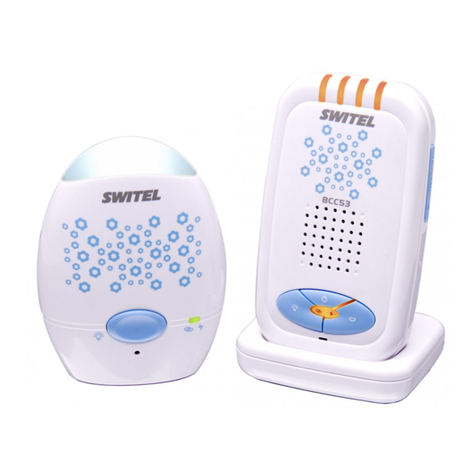
switel
switel BCC53 User manual
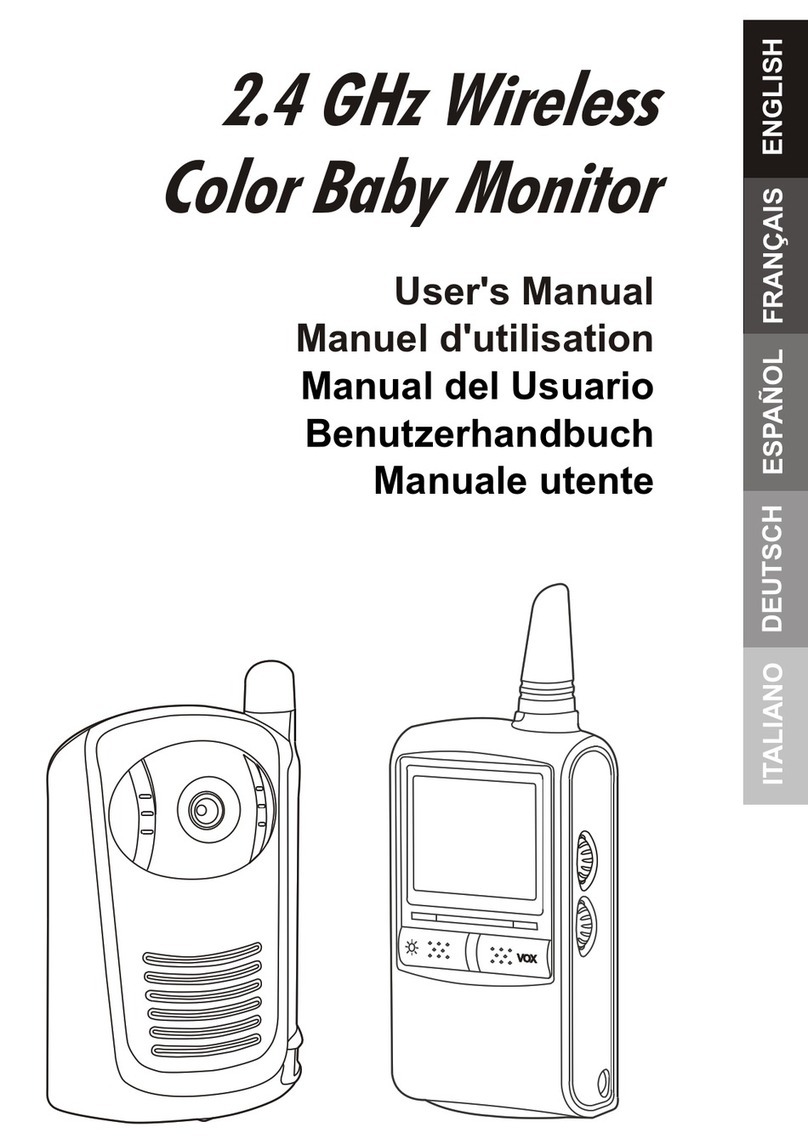
switel
switel BCF4368 User manual

switel
switel BCC 68 User manual
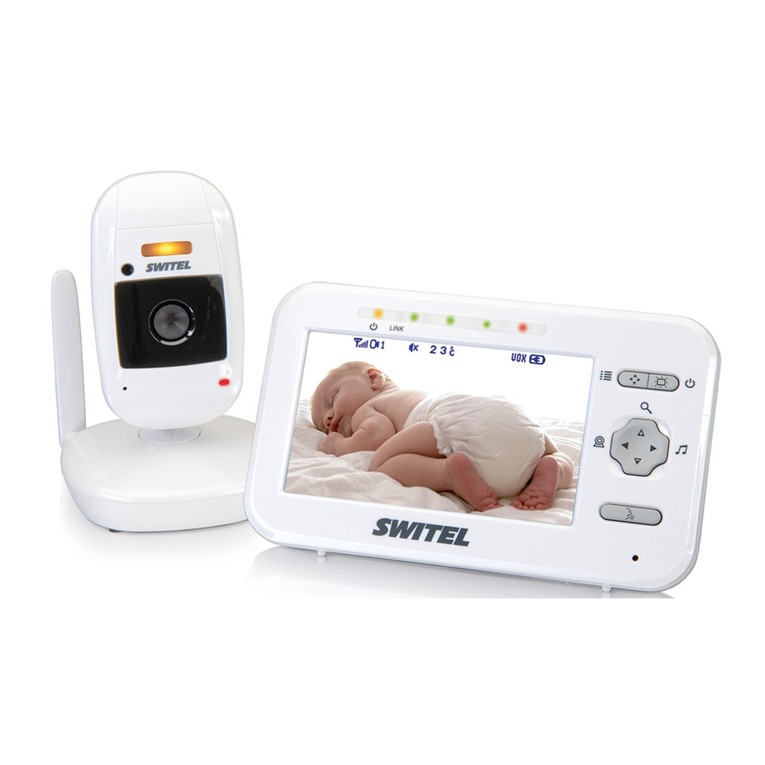
switel
switel BCF 986 User manual

switel
switel BCF820 User manual
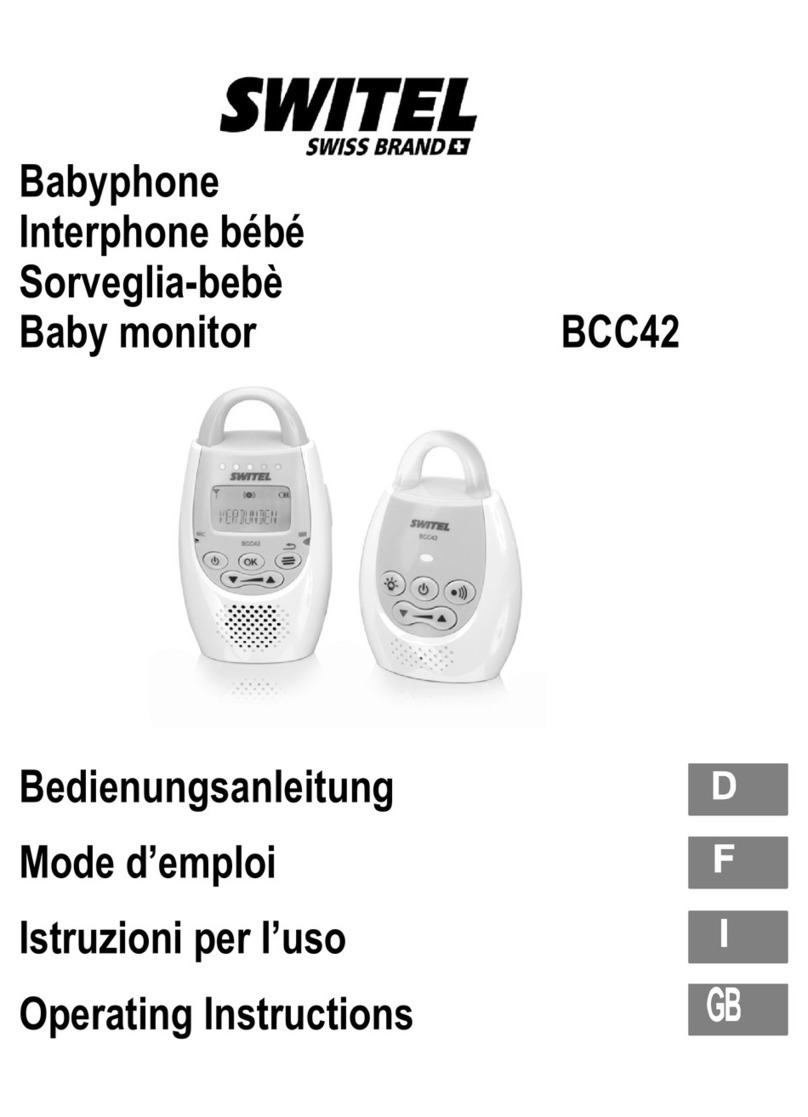
switel
switel BCC42 User manual

switel
switel BCF 877 Nanny User manual

switel
switel BCF 817 User manual

switel
switel BCE25 User manual
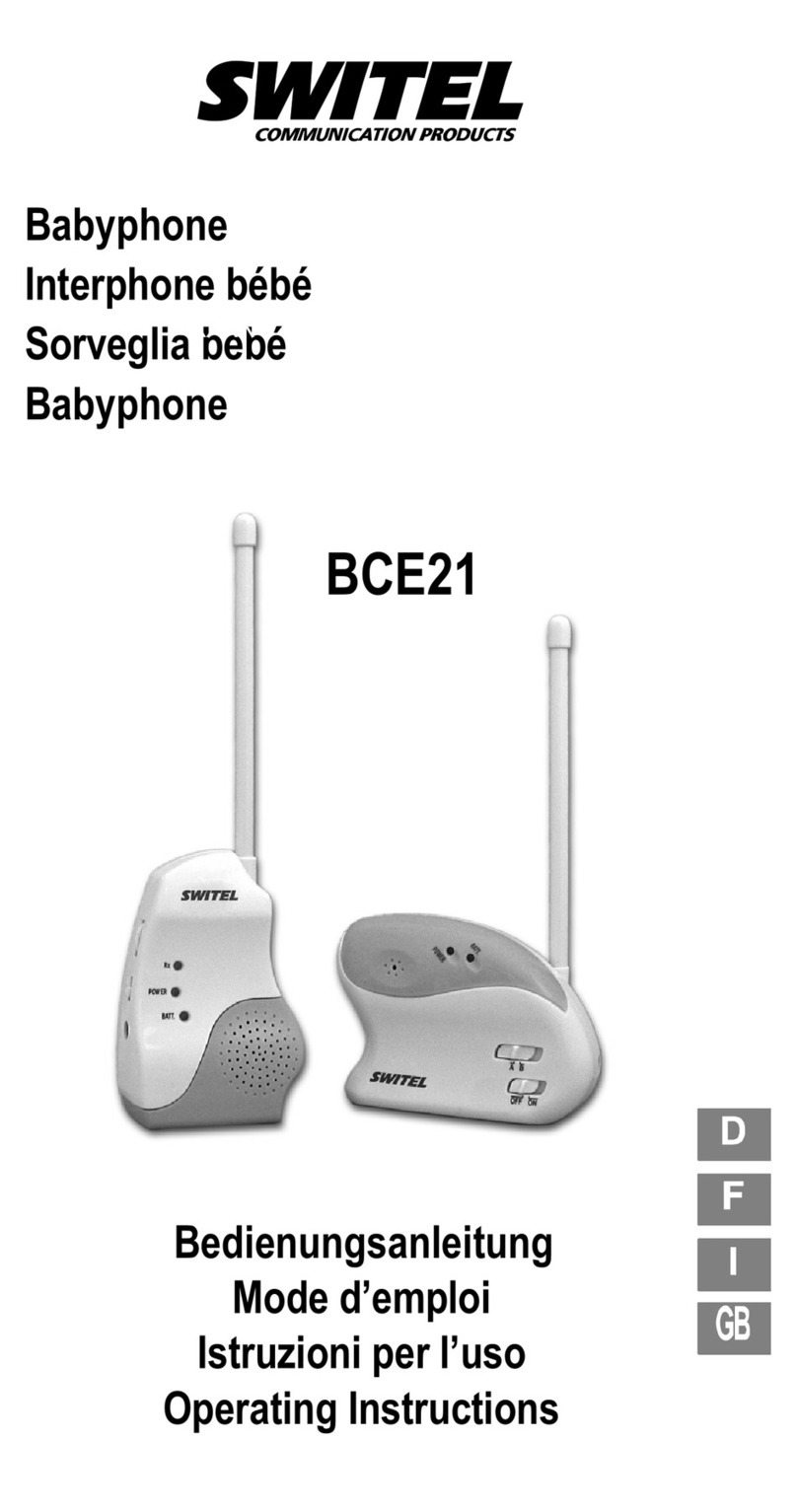
switel
switel BCE21 User manual

switel
switel BC109 User manual

switel
switel BCF989 User manual
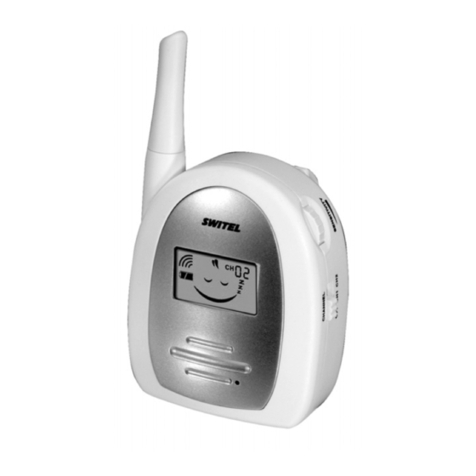
switel
switel BCC 47 User manual
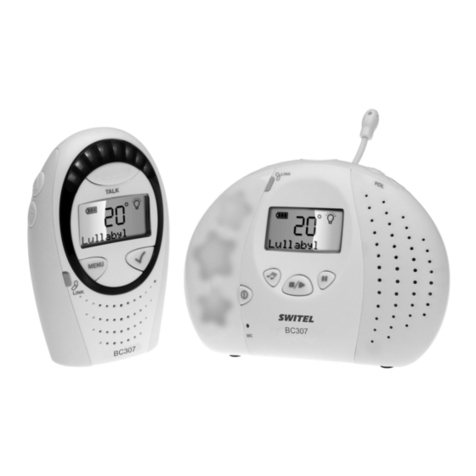
switel
switel BC-307 User manual

switel
switel BC-108 User manual

switel
switel BCF 860 User manual
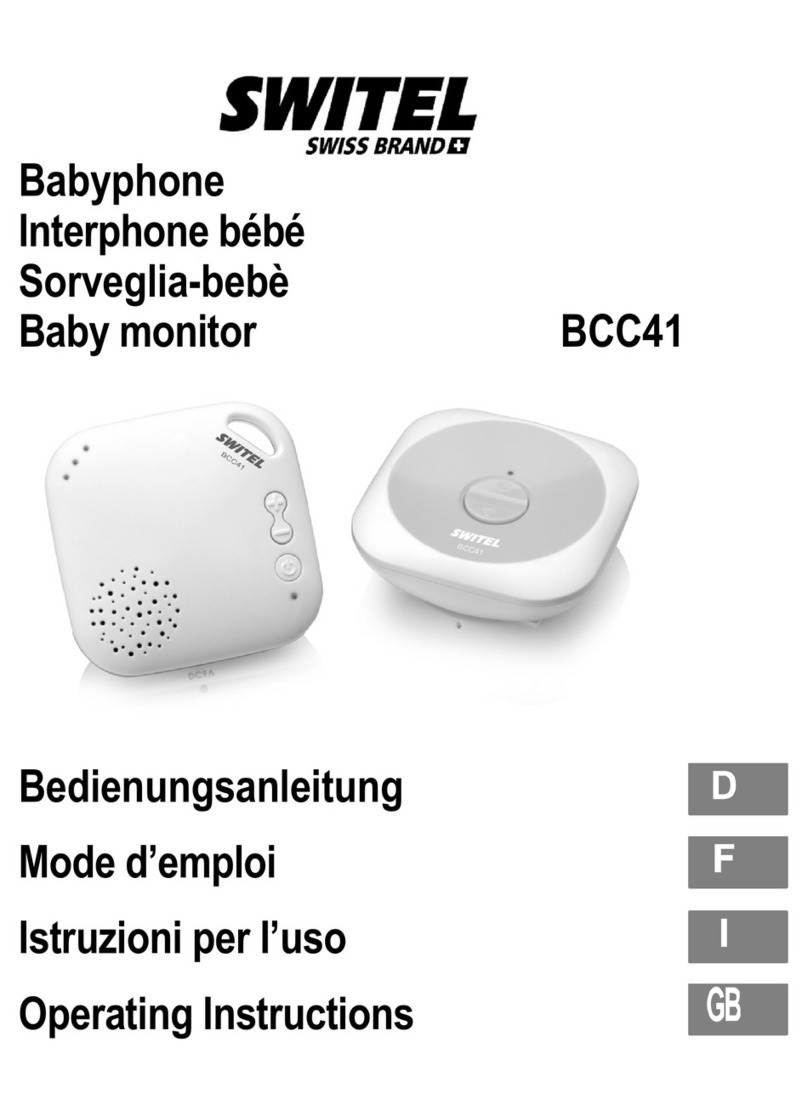
switel
switel BCC41 User manual
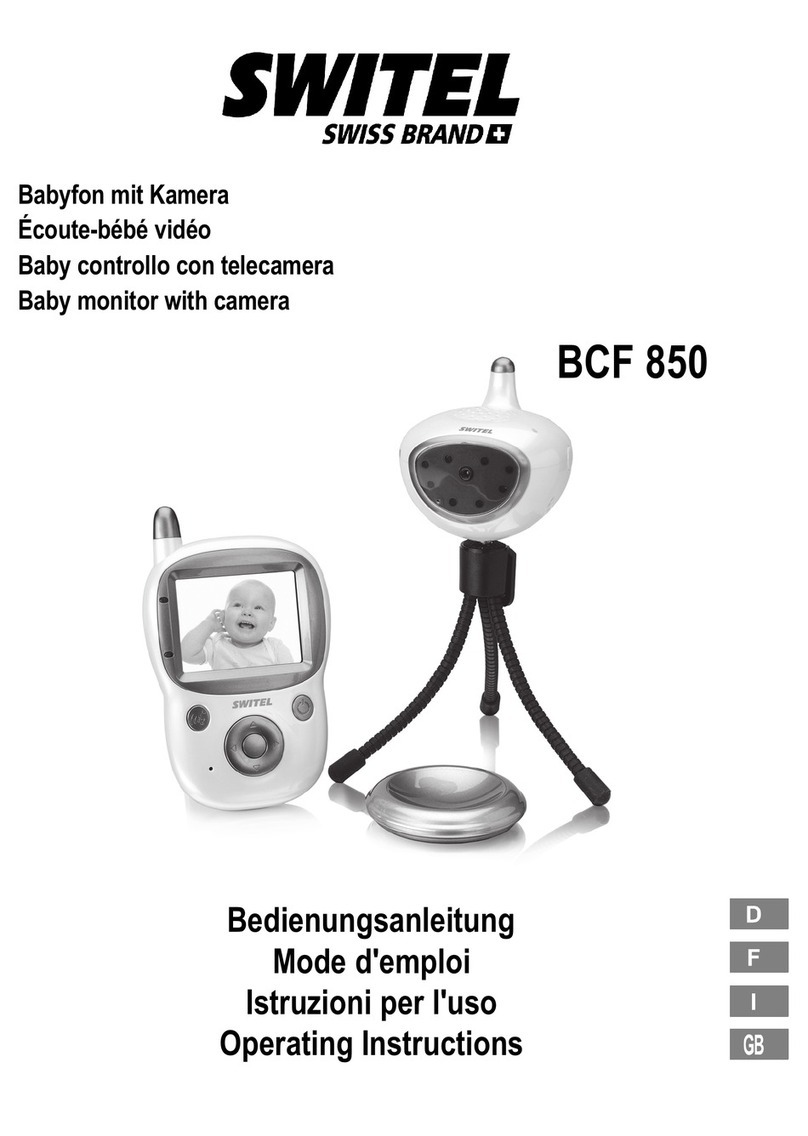
switel
switel BCF 850 User manual
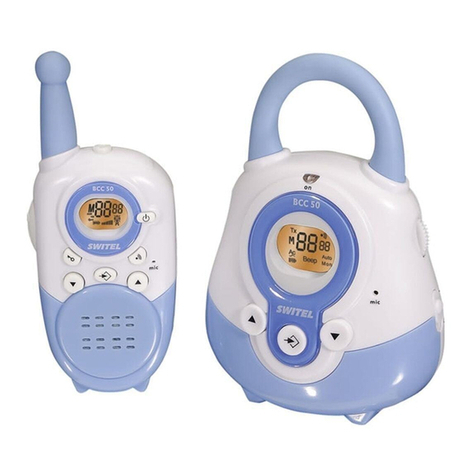
switel
switel BCC 50 User manual

switel
switel BCF 809 User manual
